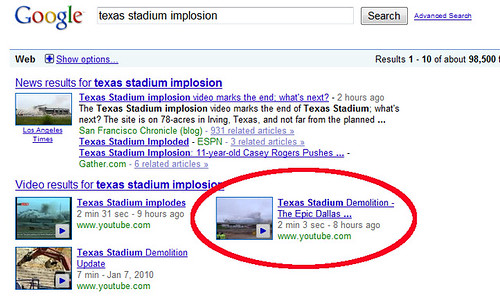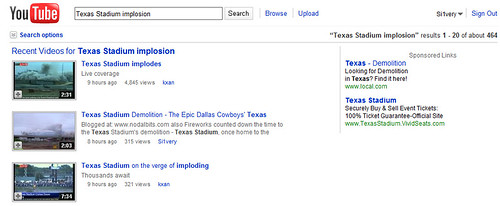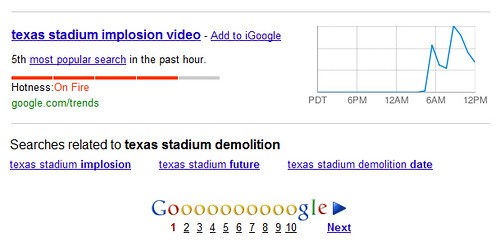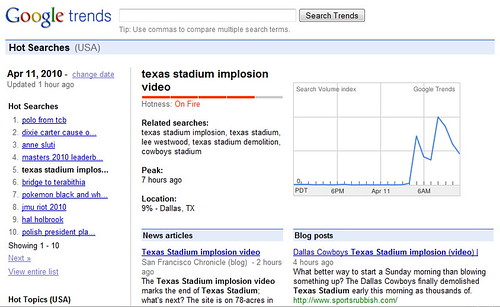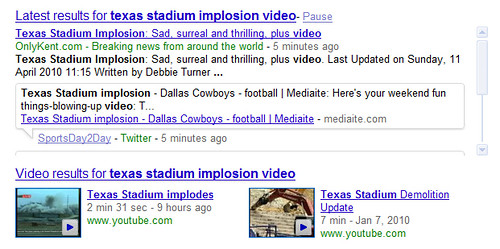Yesterday, I went down to Dallas’s famous Texas Stadium to film and photograph its widely-publicised demolition. I often film and photograph events near me as practice and example for search engine optimization. In this case, my optimization work was fairly straightforward, and the results were spectacular. Here’s the video I shot of the Texas Stadium Implosion:
(This wasn’t the first Dallas Cowboys Football-related spectacle I’ve covered – I previously photographed the tragedy of the collapse of the Dallas Cowboys practice field roof near where I live.)
My video’s quality actually wasn’t all that hot, I must admit. The demolition was to occur a little after daybreak, at near 7:00 a.m., and it was cloudy. I did try to get a vantage point as close as possible where there was very little jockeying for position from the crowd of thousands who showed to witness the event. I also planned ahead sufficiently to prepare by bringing a folding chair, allowing me to stand above the crowd around me.
But, I was unsure how long the demolition would take – things like this can be unpredictable. So, I set my camera (a Nikon Coolpix S51 that I’ve used all the way around the world) to a little lower resolution, “small size 320”, instead of higher resolution. This gave me more minutes of film time, and allowed me room to shoot some photos as well.
Even considering that my video was not of the highest quality of those posted for the demolition, and even though some others had better vantage points, my video became one of the top two most popular posted on YouTube, ranking in searches there as well as within Google, under Universal Search. So, how did I accomplish it in one day flat?
It starts with the title – I predicted that people would search for both “Texas Stadium Implosion” as well as “Texas Stadium Demolition” to find this content. So, I included BOTH of those terms in the title. I also wanted to include “Dallas Cowboys” in it, and try to describe it compellingly to increase clickthroughs, so I mentioned “Epic”. Here’s the title I engineered to attempt to target many of the most popular search query combinations people might use in trying to find videos of the explosion:
“Texas Stadium Demolition – The Epic Dallas Cowboys’ Texas Stadium Implosion!”
Second, I gave the video a keyword-rich description which further reinforced each of the main keyword phrases I was targeting. I custom-wrote the description, mentioning a small amount of the facts outlined in the Wikipedia article for the Texas Stadium.
One subtlety of the description was my inclusion of a link over to my personal blog, where I’d written a matching blog post about the experience, “Texas Stadium Implosion – Huge Demolition Event“. This allowed people who came across the video to read up my longer description of the whole deal.
In YouTube, I did a few other things as well. I specified which of the three video stills would be used as the thumbnail preview for the vid when it appears in search results (oh, how I wish they’d allow more choices or would allow one to upload a custom image for that).
I also set loosest requirements for user interactions with the video page, allowing people to rapidly interact with the page with instant gratification. Allowing instant gratification in this manner can encourage more and faster user-interactions with the page such as comments, video responses, voting on comments, ratings, embedding and syndication. While setting loose requirements often makes major corporations very nervous, my settings show how enabling rapid interactions can push the success of a video, since many of these YouTube components are signals for user-interest and therefore rankings. Having these interactions appear rapidly is more vital under Google’s RealTime Search algorithms.
Finally, I also set the Date to display “Today”, and associated the video with the map location of the Texas Stadium in Irving, allowing the vid to essentially be geocoded to appear in local search results in Google Maps.
Outside of YouTube, I twittered about the Texas Stadium implosion frequently, and also posted my still photos of it on Flickr at “Texas Stadium Implosion“.
In my blog post about the demolition, I embedded the video. I also linked to the video from the Flickr images and from my Twitter updates. I later blogged again from another blog, posting “Texas Stadium Demolition Case Study – YouTube Still Tops For Video Promotion” on Natural Search Blog.
What were the results? Well, the video has had over 55,000 views yesterday, and over a hundred comments!
My Texas Stadium video appears prominently in various related Google Search results:
It also appears prominently within various YouTube search results, allowing people seeking it to find it easily and interact with it further:
Google automatically is generating a Google Trends graph now, highlighting how “Texas Stadium implosion video” is now one of the top-five trending phrases today:
As further evidence that Google has found the terms to be important, Google’s Real-Time Search Results interface has automatically kicked in, scrolling away Twitter and blog mentions of the event:
All this to show that achieving top rankings in YouTube and Google search results for video search is not rocket science! There are a few other subtle things that I did in performing the video optimizations, but I’ve outlined many of the most-impactful ones in this article.
To get Google Real-Time Search to sing in harmony with keyword search and YouTube search, it’s vital to post content as rapidly as possible as the related search terms first begin trending. It’s also vital to perform solid video SEO, and to encourage rapid/frequent user-generated content on the video’s main page in YouTube.
I know that many of you reading this who are building video optimization tactics for promoting major corporation websites are probably concerned about whether you are too vulnerable to malicious comments on your video pages – and this is a valid concern! If you read the comments on my video page, you’ll see that people have used foul language, insulted one another, gotten into arguments, posted conspiracy theories, etc.
Cool thing is, YouTube provides robust tools for controlling your video pages. You can delete these comments and also go back to change the setting to require that all comments and “video responses” get moderated and approved by you prior to publishing. So, for corporate work, I’d suggest initially allowing the loose interaction rules until your video really goes hot, then circle back around to delete comments you don’t want to appear and tighten the posting to enable your moderation. In this way, you can achieve popular content, then after your video is established, sanitize any content you dislike and lock it down to keep further from appearing. So, your risk of negativity is very temporary.
Using an interlocking strategy of social media, realtime search tactics, and solid video SEO will allow you to maximize the success of your video content, giving you a significant weapon to use in your online marketing arsenal.

